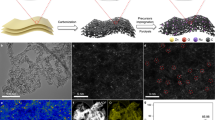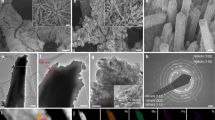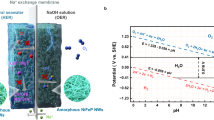Abstract
As one of the most widely used disinfectants, active chlorine is synthesized predominantly through electrolysis of saturated sodium chloride solutions, an industrial process known as the chlor-alkali process, with high energy consumption. Seawater is an abundant source of chloride and thus an ideal alternative electrolyte. However, substantial challenges are to be addressed, notably the competing oxygen evolution reaction and progressive anode passivation due to the presence of rich cations in seawater. Here, we show durable and efficient active chlorine electrosynthesis directly from natural seawater with intrinsic turnover frequency and mass activity two orders of magnitude higher than the state of the art. The essential chemistry is an Fe-doped Ti4O7 anode that strengthens the electrophilicity of lattice oxygen to allow for site-selective chloride activation at remarkably lowered kinetic overpotentials relative to the oxygen evolution reaction, while also impeding the precipitation of alkaline earth metal cations on the Ti4O7 surface. A seawater splitting device with an integrated commercial silicon photovoltaic cell delivers an impressive active chlorine production rate of 3.15 mg min−1 for effective simulated ballast water disinfection. This work suggests the possibility to substantially improve the sustainability of the chlor-alkali process without compromising the synthetic performance for the mass production of disinfectants.
This is a preview of subscription content, access via your institution
Access options
Access Nature and 54 other Nature Portfolio journals
Get Nature+, our best-value online-access subscription
$29.99 / 30 days
cancel any time
Subscribe to this journal
Receive 12 digital issues and online access to articles
$119.00 per year
only $9.92 per issue
Buy this article
- Purchase on Springer Link
- Instant access to full article PDF
Prices may be subject to local taxes which are calculated during checkout






Similar content being viewed by others
Data availability
Source data are provided with this paper.
References
Ha, H. et al. Highly selective active chlorine generation electrocatalyzed by Co3O4 nanoparticles: mechanistic investigation through in situ electrokinetic and spectroscopic analyses. J. Phys. Chem. Lett. 10, 1226–1233 (2019).
Lim, T. et al. Atomically dispersed Pt–N4 sites as efficient and selective electrocatalysts for the chlorine evolution reaction. Nat. Commun. 11, 412 (2020).
Wang, Y., Liu, Y., Wiley, D., Zhao, S. & Tang, Z. Recent advances in electrocatalytic chloride oxidation for chlorine gas production. J. Mater. Chem. A 9, 18974–18993 (2021).
Chen, S., Zheng, Y., Wang, S. & Chen, X. Ti/RuO2–Sb2O5–SnO2 electrodes for chlorine evolution from seawater. Chem. Eng. J. 172, 47–51 (2011).
Hsu, S.-H. et al. An earth-abundant catalyst-based seawater photoelectrolysis system with 17.9% solar-to-hydrogen efficiency. Adv. Mater. 30, 1707261 (2018).
Trasatti, S. Electrocatalysis: understanding the success of DSA®. Electrochim. Acta 45, 2377–2385 (2000).
Yao, Y. et al. Single Atom Ru monolithic electrode for efficient chlorine evolution and nitrate reduction. Angew. Chem. Int. Ed. Engl. 61, e202208215 (2022).
Vos, J. G. et al. Selectivity trends between oxygen evolution and chlorine evolution on iridium-based double perovskites in acidic media. ACS Catal. 9, 8561–8574 (2019).
Exner, K. S. Controlling stability and selectivity in the competing chlorine and oxygen evolution reaction over transition metal oxide electrodes. ChemElectroChem 6, 3401–3409 (2019).
Karlsson, R. K. B. & Cornell, A. Selectivity between oxygen and chlorine evolution in the chlor-alkali and chlorate processes. Chem. Rev. 116, 2982–3028 (2016).
Wintrich, D. et al. Enhancing the selectivity between oxygen and chlorine towards chlorine during the anodic chlorine evolution reaction on a dimensionally stable anode. ChemElectroChem 6, 3108–3112 (2019).
Dong, H., Yu, W. & Hoffmann, M. R. Mixed metal oxide electrodes and the chlorine evolution reaction. J. Phys. Chem. C 125, 20745–20761 (2021).
Chen, H. et al. Wood aerogel-derived sandwich-like layered nanoelectrodes for alkaline overall seawater electrosplitting. Appl. Catal. B 293, 120215 (2021).
Yu, L. et al. Hydrogen generation from seawater electrolysis over a sandwich-like NiCoN|NixP|NiCoN microsheet array catalyst. ACS Energy Lett. 5, 2681–2689 (2020).
Hausmann, J. N., Schlögl, R., Menezes, P. W. & Driess, M. Is direct seawater splitting economically meaningful? Energy Environ. Sci. 14, 3679–3685 (2021).
Goryachev, A. et al. Electrochemical stability of RuO2(110)/Ru(0001) model electrodes in the oxygen and chlorine evolution reactions. Electrochim. Acta 336, 135713 (2020).
Escudero-Escribano, M. et al. Importance of surface IrOx in stabilizing RuO2 for oxygen evolution. J. Phys. Chem. B 122, 947–955 (2018).
You, S. et al. Monolithic porous Magnéli-phase Ti4O7 for electro-oxidation treatment of industrial wastewater. Electrochim. Acta 214, 326–335 (2016).
Geng, P., Su, J., Miles, C., Comninellis, C. & Chen, G. Highly-ordered Magnéli Ti4O7 nanotube arrays as effective anodic material for electro-oxidation. Electrochim. Acta 153, 316–324 (2015).
Tao, X. et al. Strong sulfur binding with conducting Magnéli-phase TinO2n–1 nanomaterials for improving lithium–sulfur batteries. Nano Lett. 14, 5288–5294 (2014).
Senevirathne, K., Hui, R., Campbell, S., Ye, S. & Zhang, J. Electrocatalytic activity and durability of Pt/NbO2 and Pt/Ti4O7 nanofibers for PEM fuel cell oxygen reduction reaction. Electrochim. Acta 59, 538–547 (2012).
Yao, C., Li, F., Li, X. & Xia, D. Fiber-like nanostructured Ti4O7 used as durable fuel cell catalyst support in oxygen reduction catalysis. J. Mater. Chem. 22, 16560–16565 (2012).
Gu, H. et al. Adjacent single-atom irons boosting molecular oxygen activation on MnO2. Nat. Commun. 12, 5422 (2021).
Chen, Y. et al. Isolated single iron atoms anchored on N-doped porous carbon as an efficient electrocatalyst for the oxygen reduction reaction. Angew. Chem. Int. Ed. Engl. 56, 6937–6941 (2017).
Quan, F. et al. Electrochemical removal of ammonium nitrogen in high efficiency and N2 selectivity using non-noble single-atomic iron catalyst. J. Environ. Sci. 125, 544–552 (2023).
Jing, Y., Almassi, S., Mehraeen, S., LeSuer, R. J. & Chaplin, B. P. The roles of oxygen vacancies, electrolyte composition, lattice structure, and doping density on the electrochemical reactivity of Magnéli phase TiO2 anodes. J. Mater. Chem. A 6, 23828–23839 (2018).
Exner, K. S. Beyond the traditional volcano concept: overpotential-dependent volcano plots exemplified by the chlorine evolution reaction over transition-metal oxides. J. Phys. Chem. C. 123, 16921–16928 (2019).
Yang, J. et al. Regulating the tip effect on single-atom and cluster catalysts: forming reversible oxygen species with high efficiency in chlorine evolution reaction. Angew. Chem. Int. Ed. Engl. 61, e202200366 (2022).
Exner, K. S., Anton, J., Jacob, T. & Over, H. Full kinetics from first principles of the chlorine evolution reaction over a RuO2 (110) model electrode. Angew. Chem. Int. Ed. Engl. 55, 7501–7504 (2016).
Karlsson, R. K. B., Hansen, H. A., Bligaard, T., Cornell, A. & Pettersson, L. G. M. Ti atoms in Ru0.3Ti0.7O2 mixed oxides form active and selective sites for electrochemical chlorine evolution. Electrochim. Acta 146, 733–740 (2014).
Hansen, H. A. et al. Electrochemical chlorine evolution at rutile oxide (110) surfaces. Phys. Chem. Chem. Phys. 12, 283–290 (2010).
Cho, J. et al. Importance of broken geometric symmetry of single-atom Pt sites for efficient electrocatalysis. Nat. Commun. 14, 3233 (2023).
Exner, K. S., Anton, J., Jacob, T. & Over, H. Chlorine evolution reaction on RuO2(110): ab initio atomistic thermodynamics study—Pourbaix diagrams. Electrochim. Acta 120, 460–466 (2014).
Sumaria, V., Krishnamurthy, D. & Viswanathan, V. Quantifying confidence in DFT predicted surface Pourbaix diagrams and associated reaction pathways for chlorine evolution. ACS Catal. 8, 9034–9042 (2018).
Yi, D. et al. Regulating charge transfer of lattice oxygen in single-atom-doped titania for hydrogen evolution. Angew. Chem. Int. Ed. Engl. 132, 15989–15993 (2020).
Deng, J. et al. Triggering the electrocatalytic hydrogen evolution activity of the inert two-dimensional MoS2 surface via single-atom metal doping. Energy Environ. Sci. 8, 1594–1601 (2015).
Liu, J. et al. Low-dimensional metal–organic frameworks with high activity and selectivity toward electrocatalytic chlorine evolution reactions. J. Phys. Chem. C. 126, 7066–7075 (2022).
Wang, W. et al. Visible light-induced marine bacterial inactivation in seawater by an in situ photo-fenton system without additional oxidants: implications for ballast water sterilization. ACS EST Water 1, 1483–1494 (2021).
Chen, S. et al. Induction of Escherichia coli into a VBNC state through chlorination/chloramination and differences in characteristics of the bacterium between states. Water Res. 142, 279–288 (2018).
Lee, O.-M., Kim, H. Y., Park, W., Kim, T.-H. & Yu, S. A comparative study of disinfection efficiency and regrowth control of microorganism in secondary wastewater effluent using UV, ozone, and ionizing irradiation process. J. Hazard. Mater. 295, 201–208 (2015).
Acknowledgements
This work was supported by the National Key Research and Development Program of China (grant nos. 2022YFC3702101, 2021YFA1201701, 2022YFA1505000), the National Natural Science Foundation of China (grant nos. U22A20402, 21936003, 22076061, 22206124), the Natural Science Foundation of Shanghai (grant no. 23ZR1431000) and the China Postdoctoral Science Foundation (grant no. 2022M712049).
Author information
Authors and Affiliations
Contributions
L.Z. and H.L. supervised the project. H.L., S.Z. and H.S. conceived and designed the experiments. S.Z. conducted the material synthesis and characterizations, the electrochemical experiments and the DFT calculations. G.Z. contributed to the DFT calculations. H.S., Y.S. and Y.J. contributed to the sterilization experiment. M.L. and C.L. contributed to the electrode manufacture. J.D. and Y.Y. commented on the manuscript. S.Z., H.L. and L.Z. wrote the manuscript.
Corresponding authors
Ethics declarations
Competing interests
The authors declare no competing interests.
Peer review
Peer review information
Nature Sustainability thanks Kai Exner and the other, anonymous, reviewer(s) for their contribution to the peer review of this work.
Additional information
Publisher’s note Springer Nature remains neutral with regard to jurisdictional claims in published maps and institutional affiliations.
Supplementary information
Supplementary Information
Supplementary Figs. 1–37 and Tables 1–3.
Source data
Source Data Fig. 1
Source data for the XRD patterns, normalized XANES spectra and Fourier-transform K-edge EXAFS spectra.
Source Data Fig. 2
Source data for the electrochemical performance.
Source Data Fig. 3
Source data of electrochemically active surface areas, Cl 2p XPS and H2-TPR.
Source Data Fig. 4
Source data for the chronopotentiometric curve, Ca2+ 2p XPS and Zeta potential.
Source Data Fig. 5
Source data for TDOS and PDOS.
Source Data Fig. 6
Source data for the J-V curve, AC electrochemical synthesis and sterilization.
Rights and permissions
Springer Nature or its licensor (e.g. a society or other partner) holds exclusive rights to this article under a publishing agreement with the author(s) or other rightsholder(s); author self-archiving of the accepted manuscript version of this article is solely governed by the terms of such publishing agreement and applicable law.
About this article
Cite this article
Zhao, S., Li, H., Dai, J. et al. Selective electrosynthesis of chlorine disinfectants from seawater. Nat Sustain 7, 148–157 (2024). https://doi.org/10.1038/s41893-023-01265-8
Received:
Accepted:
Published:
Issue Date:
DOI: https://doi.org/10.1038/s41893-023-01265-8



